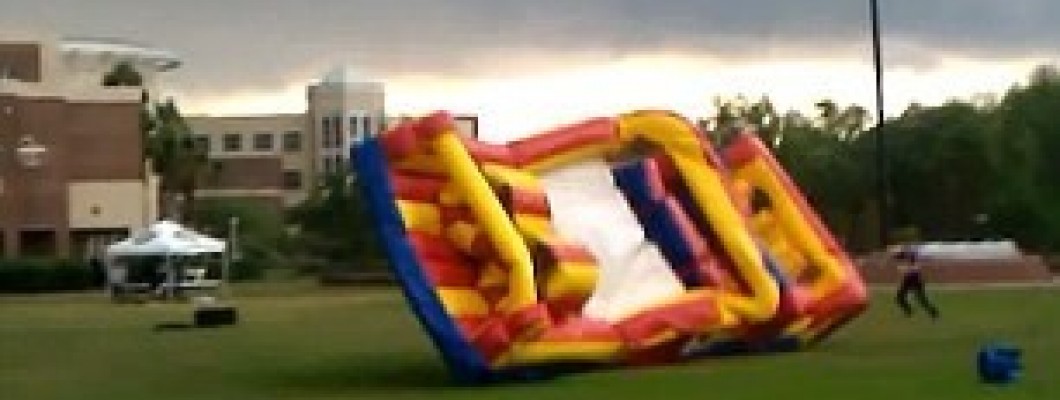
There are several possible causes for the increase in injuries. Among these causes are environmental conditions, operator error, equipment failure, overcrowding, rough housing, etc.
1 Environmental – Wind and Rain
Wind
Wind is often a factor in injuries caused by inflatables. There have been cases of sudden gusts of wind blowing over inflatables. In July of 2005, “at least three children were injured when a gust of wind sent an inflatable castle flying through the air. The children fell 25-35 feet and landed on pavement. One child was hospitalized in intensive care; two others required surgery.

Rain
Another dangerous environmental condition for inflatable rides is rain. The rides can become slippery and people can slide off the inflatable causing injury. The rain can also make ground conditions troublesome by muddying the soil. This can prevent the inflatable from being staked down properly or sufficiently.

2 Human Causes – Overcrowding, Operator Error and Other Causes
Overcrowding
Overcrowding is an identified hazard for inflatable rides. In June of 2004 “eight children were injured in a 20-foot fall from an inflatable ride after the ride collapsed. The children were taken to hospitals for treatment of their injuries, most of which were minor.
Overcrowding can occur for many reasons. The reason for overcrowding can be as simple as the operators are unaware of the maximum number of occupants. Other times the occupants can cause the overcrowding themselves, either by not listening to the operator or not reading any signs if they are present.

Operator Error
Too many operators regard inflatable rides as ‘big and soft’ and relatively harmless.
In May of 2005, a 24-year-old woman died from injuries. She sustained in a fall from an inflatable climbing wall. Normally, the ride attendant wears a strap around his waist or cinches it to the platform below to prevent a climber’s fall; however the attendant who was working with the victim had apparently failed to attach the strap around his waist, and was not holding it incorrectly. Her legs and lower body hit the inflated base and her head and upper body hit the pavement, resulting in serious head 34 trauma. She died due to these injuries three days later.
Throughout the research there has been a recurring theme; that having attentive, properly trained operators is the first step to reducing injuries on inflatable amusements.

Other Causes
Equipment failure, though rare, can be very dangerous.Cables that have been improperly repaired or inflatable attractions that have been quickly patched can cause serious injury. Blowers that suddenly stop working can cause the ride to deflate rapidly and often without warning. This can lead to situations that are very unsafe.

The human factor can often come into play. Rough-housing on an inflatable ride can be very dangerous, especially on an inflatable slide or other tall ride. A child could lose their balance and fall, potentially hurting themselves.

Another problem that occurs in the inflatable industry is insufficient communication with, or training of, the operator. In April of 2005, “an inflatable ride was carried away in strong winds with a 5-year-old girl and her 22-month-old sister inside. The girls suffered only minor injuries. The girls’ parents rented the ride — an inflatable castle in which children bounce. They say that the release form that they signed warned of the dangers that high winds pose to inflatable rides, but that they never read the paperwork. They say that the rental company should have warned them.

Written by Doris from East Inflatables.

Leave a Comment